Marcus and I decided to take my mom over to Jewel Bako for her birthday -- it's been on my "list" of places to dine at for a while (thanks to Linda's past praise for it), and since my mom's favorite cuisine is Japanese, it seemed like the perfect place to take her.
This little gem (literally one, as its name really translates to "jewel box" in Japanese) happens to be adjacent to Degustation (where we ate late last year) -- in fact, they're both owned and run by boutique restauranteur, Jack Lamb. The unlikely story of how this hot spot sushi bar came to be is quite serendipitous. Back in 2001, Mr. Lamb, daylighting in the law profession at the time, spotted a "For Lease" sign across the street from the townhouse he had recently purchased with his wife, Grace. Soon enough, the couple soon "made the transition to restaurateuring, making a splash on the culinary scene" with a tiny (but by no means lacking in cuisine) sushi bar Jewel Bako.
When I called to make reservations, I emphasized that we be seated right at the sushi bar (something you should definitely do if you have a small party of 2-3 -- no question), so we can interact with the sushi chef(s) and have an intimate experience with the assortment of raw fish ahead. The gilded décor certainly gave way for what was to come -- the accompanying, pretty little treasures like the golden charger plate, the vintage bronze napkin holders, the flat shiny stones for resting chopsticks, and a mother of pearl coasters to delicately hold your glass of water.
I love the restaurant's logo embossed on the menu's cover -- an abstraction of circular shapes and rounded rectangles to emulating the recurring theme of jewels (literal ones or delectable pieces of nigiri sushi).
Inside one of the main dining areas.
The sushi bar's actual "jewel box" of fish, ready to be sliced and served.
While we were getting settled in, we were watching one of the sushi chefs work his magic for a platter of sushi for one of the tables in the main dining room.
The sushi bar got us started with an amuse-bouche of bluefin tuna over a ball of fried sushi rice and spicy sauce, topped with scallions and tobiko. For me, it was a wonderful (and much better) execution of the usual "spicy tuna roll" I see in neighborhood sushi joints. The tuna was very smooth in texture which was nicely contrasted with the very crunchy fried sushi rice ball (I believe the sushi chef lightly torched its outer surface) and with the spicy, creamy sauce. I normally don't like tuna (I usually forgo it unless it's the fatty kind, haha), but this was quite delicious.
After perusing the menu, the three of us each decided what we wanted -- I went with the sushi omakase while Marcus and my mom each went with the sashimi omakase. As I've touched upon before, omakase loosely means "I trust you" or "I'll leave it to you" in Japanese, which is to imply here that for the price dictated on the menu ($65 at Jewel Bako), you are entrusting your dining experience and sushi selections with the chef. Utlimately, by choosing this, you expect to be getting the highlights of the restaurant's offerings and assortments of fish. I originally wanted to get the chef's tasting omakase (which is essentially a sushi omakase with some additional courses), but I wasn't sure I could eat that much that night.
As a prelude to our omakase ahead, we each had a complimentary miso soup with scallions and cubes of tofu. Very cleansing and calming, the soup was very delicious, and I liked that it wasn't overly salted.
Here's one of the sushi chefs plating the sashimi omakase platter for Marcus and my mom.
The sashimi omakase undoubtedly resembles (both visually and figuratively) a beautiful collection of "jewels" -- very fitting with the restaurant's name.
So something I don't believe I've seen before is an actual fresh wasabi root. In Japan, the traditional method for grating wasabi uses an oroshi (i.e., a sharkskin grater) -- which is what I believe was used at Jewel Bako. The important component of the grater is the teeth or nubs -- smaller teeth produce a finer paste that increases the unique heat and flavor of fresh wasabi. This is because the finer the paste, the more chemical reactions take place and thus producing a more piquant flavor and spiciness. In fact, grating wasabi releases a volatile compound (i.e., isothiocyanates) that gradually dissipate with exposure to air, making it vital for the wasabi to be grated right before eating sushi. Without grating the root into a paste, these compounds are not present until the root is broken up into a paste.
You must be wondering what you've had in other Japanese restaurants then. Most wasabi served in the United States is not actually wasabi, but instead is a powder made from dried horseradish (which is in the same family as wasabi), food coloring, and dry mustard. This is because over the years, Japanese restaurants found that fresh wasabi was not preferred by Americans, so the horseradish mixture has become the standard.
To properly grate a {1} fresh root of wasabi for us, our server cut off one end to expose its freshly cut interior and {2} rubbed the root along the oroshi to produce a finely ground wasabi paste. When the oroshi produced sufficient amount of finely ground wasabi, she would sweep it right onto the platters in front of Marcus and my mom with their sashimi omakase. This is because using the wasabi grater and keeping the resulting ground wasabi to the grating surface minimizes its exposure to the air so that the volatile compounds are allowed to develop with minimal dissipation. Its strong aroma is certain to clear any sinuses you may have!
Alongside the freshly ground wasabi root, the sashimi omakase, running from the top then left to right, consisted of bluefin tuna, botan ebi (spot prawn), Scottish salmon, k isaki (black bass) , o-toro (fatty tuna), nama dako (raw octopus), hamachi (yellowtail), kanpachi (amberjack), suzuki (sea bass), hotate (scallop) wrapped in a cucumber with yuzu, aji (jack mackerel), uni (sea urchin), and ebi (sweet shrimp).
The highlights? Upon asking Marcus what else were his favorites, he simply responded, "I don't remember which was which -- I just went, 'Ooh, colorful fish . . . nom!" But in all seriousness, Marcus loved the o-toro the best (as usual), as well as the uni (even though he's not typically a fan of it) and the Scottish salmon (noting that it had a flavor he had never tasted before -- an unexpected but an enjoyable surprise). For my mom, it was also o-toro and uni as well as the sweet shrimp. The not-so-good? Marcus and my mom were disappointed with the nama dako -- they found it a bit tough and overly chewy, making it hard to eat. Nevertheless, they still loved most of the colorful assortment set before them -- everything was fresh and stunningly presented.
Another thing to note is that our server made sure to inform us that the sashimi omakase is served all at once on a serving tray/slab, while the sushi omakase has the option of either being served this way (i.e., altogether) or piece-by-piece. I like the theatrical/live-action part of being seated at the sushi bar, so I opted for the latter service, so that way I can savor and enjoy each piece of the sushi omakase flight at a more gradual pace.
My choice of service resulted in the set-up of this leaf plate for the sushi chef to present each piece of nigiri (i.e., hand-pressed sushi) in the flight.
I even got my own nifty little plate over which to eat, as well as a vertically standing damp napkin to wipe your fingers after eating each piece of nigiri, which should be eaten in one bite. In fact, I had no idea it was acceptable (if not, encouraged) to eat nigiri sushi with your hands! So at Jewel Bako, it was my first time doing so.
I was pleasantly surprised to find Chef Sho behind the counter. Given the industry's cultural inclination (originating from Japan, of course) toward male sushi chefs, coming across a female sushi chef tends to be an uncommon happenstance, but by no means nonexistent. Fortunately, female sushi chefs have an easier time with this issue here in the U.S. With that being said, Jewel Bako certainly has a wonderfully talented chef in its sushi bar!
Chef Sho was very welcoming, with lots of spirit upon starting my sushi omakase. She crafted each piece of nigiri with much precision and finesse -- an oblong mound of vinegared sushi rice (almost resembling an oval-shaped gem, apt with the restaurant's recurring theme from its name), a generous swipe of fresh wasabi underneath neta (i.e., the topping in nigiri, whether it be seafood, egg, etc.) with a lightly painted layer of soy sauce atop. This process was repeated, with some varying preparations of the neta, for the 12 pieces of nigiri ahead in the sushi omakase.
Here were the first few pieces I had with the sushi omakase:
{1} marinated bluefin tuna - This was nicely marinated and had an intense zing of fresh wasabi which was punchy on the palate -- definitely cleared any existing sinuses I had at the time!
{2} shimaaji (striped jack) - This was snappy in bite with the same reaction to the fresh wasabi as with the bluefin tuna.
{3} seared Tasmanian king salmon with rock salt and yuzu - This was scored, criss-crossedly, on the surface of the salmon with a smoky overlay from the seared effect of the blow torch. The briny and rough texture from the rock salt added another dimension to the salmon. I enjoyed this one a lot!
{4} ishigarei (stone flounder) with yuzu zest and a shiso leaf underneath - This was very refreshing from the yuzu zest and had a nice subtle snappy texture to it.
Where are the photographs, Stefie? I hear you asking. Well, here's what happened -- I got so overly excited about the start of the sushi omakase that it totally slipped my mind that I needed to photographically document all the bites I had! I'm definitely facepalming myself now in hindsight. Gotta stay on top of this from now on! Good thing I remembered after the fourth/fifth piece. Even Marcus and my mom were saying they didn't even notice I wasn't taking photos, most likely because they were, too, entranced with the colorful fish from their sashimi omakase. Damn the alluring fish -- messing me up like that!
This was actually one of the first pieces of sushi for which I missed taking a photograph, but I requested an additional piece of it after I completed the sushi omakase because it's one of my favorite pieces to order at a sushi bar (when available, of course). This was kinmedai (golden eye snapper) with yuzu and pepper. Now if you've been keeping up with this blog, Four Tines is no stranger to this fish (see visits to 15 East and Inakaya) and its iridescent qualities (both literally and figuratively). The nigiri version of kinmedai at Jewel Bako was no different -- a smooth sliver of snapper with a zesty surprise from the yuzu-pepper dabbed on top. Absolutely love this -- definitely worth ordering, with or without any omakase!
Next was namerou (chopped jack mackerel) with shiso, ginger, and scallions. I really, really did not like this. There were too many herbs mixed in there that very much overpowered the jack mackerel. Shiso, ginger, and scallions each yield a distinctly piquant flavor already -- combining them like this in a seemingly tartare texture with the jack mackerel just did not work. The flavors did not fuse in a way that was pleasant to my taste buds at all. I felt like I was eating the interior of a raw dumpling.
Following the not-so-great namerou was o-toro (fatty tuna). Now, this was more my style. Scored criss-crossedly with soy sauce painted right on the resulting delineations, the o-toro melted right onto my tongue, barely needing to take full bites. It was the melty goodness you get when you have a really great piece of chocolate, but even better. It was almost like butter only instead of the richness of cream, it was the richness of the tuna's fatty flesh found at the bottom half of its entire filet. Also, another one of my favorites found a sushi bars -- you can never go wrong with toro of any kind! How can anyone resist or oppose its indulgent texture and flavor? I know I can't!
This next part of the flight makes the sushi omakase worth every penny. {1} Chef Sho started with a tray of golden uni (i.e., sea urchin roe) from Santa Barbara. At this point, my mouth was already watering. I would have been happily content just eating that whole tray, but my cholesterol would have probably suffered some unhealthily crazy highs. {2} Picking a generous few pieces of uni, Chef Sho placed them on a ceramic surface and proceeded to sear the top side of the uni as well as a thinly sliced raw scallop with a chef's blow torch. {3} In a tiny bowl, she placed some sushi rice at the very bottom, covering it with the seared uni and scallop then topping it all with shredded nori and cucumber. Oh my, this was undoubtedly the most buttery of textures you'll ever experience in the realm of sea fare. This little bowl of bliss brought forth many dimensions of savoriness -- the aforementioned buttery goodness, a toasty smokiness, and a highly charged experience of umami to follow. The scallop added a nice balance to the richness from its unique texture (more structured and solid) along with its clean and pure taste. The rice gave way to a satisfying ratio of matching subtle, vinegary starch to the rich flavors of the uni and scallop. Without the rice, the uni could easily overwhelm the consumer. If there's anything for which I'd go back to Jewel Bako, it would be for this, hands down.
Like it was for my mom and Marcus with their sashimi omakase, the nama dako (raw fresh octopus) with yuzu and green tea sauce was disheartening. Its appearance, while lovely and divine (it looks like a cloud for heaven's sake!), was very misleading. It did not taste like a cloud -- it was tough and too chewy in texture and there was wayyy too much wasabi coating its underside. The green tea sauce was probably the only thing I enjoyed about it, but it would've fared better if the octopus was actually edible. Pass for me.
Another one of Jewel Bako's saving graces, the kamasu (seared barracuda) with lemon juice was awesome. With three deep slivers along topside of scales, the barracuda gave way to a delectable tartare texture (unlike the namerou) matched with the smokiness from the torched skin's texture and taste. I had never had barracuda before, so it was nice to try a fish outside of my repertoire of gustatory experience. Good for individuals willing to explore outside the typical salmon-tuna-yellowtail raw fish spectrum.
Always a delight is ebi (sweet shrimp). Served in triplicate as the neka, the ebi were refreshingly veiny (not sure how else to describe this other that like so) and tapioca-like with a subtly sweet finish.
This was the last of the sushi omakase flight (nigiri number 12!) -- anago (i.e., sea eel). {1} Before the anago could be served, Chef Sho seared it between two banana leaves with her blow torch. {2} The resulting anago was warm and soft with a silken flaky texture and had just the right amount of brushed kabayaki sauce. This was pretty good (better than the average unagi I've had in sushi joints), but it wasn't necessarily the best I've had.
Marcus and my mom were still a bit hungry after their sashimi omakase, so they decided to order a large salmon skin makimono roll (one roll is typically divided into nine circular pieces) to share amongst the three of us (three each). The roll had {1} salmon skin, toasted to a crisp and {2} lettuce, cucumbers, kaiware (i.e., sprouted daikon radish seeds), and Japanese pickles, wrapped in nori and sushi rice and topped with sesame seeds and bonito flakes. The salmon skin, predictably, was awesome as well as the topped bonito flakes. Our only complaint about the roll, however, was the nori seaweed. It was very not at all crunchy enough -- very chewy and stale. And perhaps this is a personal preference thing, but I think makimono rolls are too big for my liking. As with nigiri and regular maki-sized rolls, they can typically be eaten in one bite. With a makimono roll, it is a bit more challenging to eat in one bite for two reasons: first being etiquette-driven (i.e., trying not to eat with your mouth completely full) and second being that it's just unpleasant and burdensome to eat something that is pretty fragile in structure in more than one bite. The way to go would probably to just stick to the classic salmon skin roll, given that the nori is crunchy and not stale. Overall, the salmon skin makimono roll was disappointing, considering how the restaurant's menu seems to pride itself (implied from how many are listed on the menu) on the many makimono rolls it offers a la carte and as a tasting.
After struggling with the salmon skin makimono rolls, we were all pretty full, but once our waitress told us about the desserts Jewel Bako had on its menu, we immediately made room in our stomachs!
I went with the lychee sorbet -- freshly made inhouse (at least, it tasted like it was!). Throughout each scoop, there were bits of real lychee fruit -- always a winning point with me! I found the sorbet to be a delicious palate cleanser to the end of a salt-umami driven dinner -- refreshing, slightly sweet, and fresh. Can never go wrong with those attributes in a sorbet!
Marcus and my mom (seemingly kindred spirits when it comes to order, I've noticed) were immediately enticed by the green tea ice cream sandwich -- green tea ice cream sandwiched between two chocolate cookies sprinkled with matcha powder. From the bites I stole from my mom's, you can definitely tell the difference between the ice cream at Jewel Bako versus the ones we've had at other Japanese restaurants and from Asian grocery stores. My mom and I observed that the latter two generally have a "green tea" taste, but it just tastes artificial. The ice cream at Jewel Bako tasted like frozen green tea -- fresh, bitter (in the way that is calming in a tea), and ultimately homemade (i.e., most likely infused with real matcha leaves or powder). If you do wish to have a dessert at Jewel Bako, this would be it. Consider it like a Japanese Oreo cookie.
My mom and me seated at Jewel Bako's sushi bar.
Before I forget, just wanted to say: Happy (Early) Birthday, Mom! Hope you enjoyed Jewel Bako as much as Marcus and I did! Love you :D!
Findings: All in all, we had a lovely time at Jewel Bako. Not that I was expecting something horrible, but I was shocked (in a good way, of course) to find that the sushi bar was not at all as stuffy as I had anticipated. From what I had heard from the grape vine and various reviews, people complained that the environment was somewhat hoity-toity. I'm sure I would feel that way in the dining rooms, likely to be attributable to its super dark ambiance. The dining room, in contrast, was quite intimate -- you can even say crowded and cramped, which is not something I like to experience at all in a fine dining establishment. With that being said, I'm relieved (and very glad) that we opted to sit at the sushi bar -- it felt more open and welcoming with bright but tasteful lighting and with Chef Sho behind the counter. Lighting did wonders for our experience -- my mom always says, we should be able to see the food that you're eating. Also, it's just fun to interacting with the individual that's delicately crafting your food. Plus, I'm sure the chefs like it when you converse with them -- makes the time go by faster and more enjoyably!
Strangely enough, we were the only ones to be seated at the dining table that day until we were nearing the end of our meal, reason being that most of the guests in the dining area were larger-sized parties that the sushi bar could not effectively accommodate, especially if all the guests wanted to interact and converse with each other. The resulting semi-private atmosphere most certainly made us feel comfortable and at home enough to enjoy the high quality fish kept in Jewel Bako's own imported "jewel box" of exotic fish and sea fare without the unnecessary highfalutin nonsense you encounter at so many places of the same gastronomic caliber. The fish at Jewel Bako is incredibly fresh -- in fact, the restaurant's ability to fly in fish directly from purveyors in Japan is key. Jewel Bako serves its imported fish the day after they are caught. As a result, our omakase experience, minus the few hit-or-miss items like the nama dako and namerou, was comparable to the dinner Marcus and I had at 15 East back in 2010. The assortment of fish offered was impressive -- the kamasu (i.e., barracuda) was something I've never had before. Same goes for Marcus and his experience with the Scottish salmon. It is refreshing to know that when I try new fine sushi bars (like Jewel Bako, 15 East, and Sushi of Gari) that I'm bound to encounter a new type of fish. But of course, there will always be those favorites that I'll want to come back to experience again (like o-toro, kinmedai, and ebi) and the promise of new ones (like the seared Tasmanian king salmon, kamasu, and seared uni and scallop at Jewel Bako). Overall, Jewel Bako delivered a fantastic experience for us to celebrate my mom's birthday this year. So my advice for those who wish to go: sit at the sushi bar, order the sushi omakase -- you'll get more "bang" in kinds of fish for your buck -- and nom away. You'll be glad you did.
Strangely enough, we were the only ones to be seated at the dining table that day until we were nearing the end of our meal, reason being that most of the guests in the dining area were larger-sized parties that the sushi bar could not effectively accommodate, especially if all the guests wanted to interact and converse with each other. The resulting semi-private atmosphere most certainly made us feel comfortable and at home enough to enjoy the high quality fish kept in Jewel Bako's own imported "jewel box" of exotic fish and sea fare without the unnecessary highfalutin nonsense you encounter at so many places of the same gastronomic caliber. The fish at Jewel Bako is incredibly fresh -- in fact, the restaurant's ability to fly in fish directly from purveyors in Japan is key. Jewel Bako serves its imported fish the day after they are caught. As a result, our omakase experience, minus the few hit-or-miss items like the nama dako and namerou, was comparable to the dinner Marcus and I had at 15 East back in 2010. The assortment of fish offered was impressive -- the kamasu (i.e., barracuda) was something I've never had before. Same goes for Marcus and his experience with the Scottish salmon. It is refreshing to know that when I try new fine sushi bars (like Jewel Bako, 15 East, and Sushi of Gari) that I'm bound to encounter a new type of fish. But of course, there will always be those favorites that I'll want to come back to experience again (like o-toro, kinmedai, and ebi) and the promise of new ones (like the seared Tasmanian king salmon, kamasu, and seared uni and scallop at Jewel Bako). Overall, Jewel Bako delivered a fantastic experience for us to celebrate my mom's birthday this year. So my advice for those who wish to go: sit at the sushi bar, order the sushi omakase -- you'll get more "bang" in kinds of fish for your buck -- and nom away. You'll be glad you did.
Price point: $65 per person for sushi or sashimi omakase, $18 for salmon skin makimono roll, $6-8 for each dessert (from what I recall).
--February 4, 2012
Jewel Bako
239 East 5th Street
New York, 10003



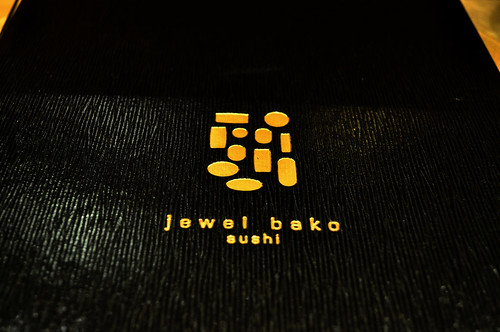
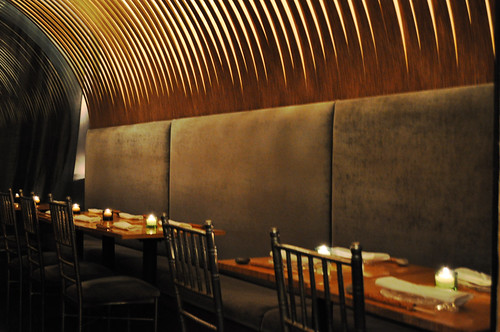
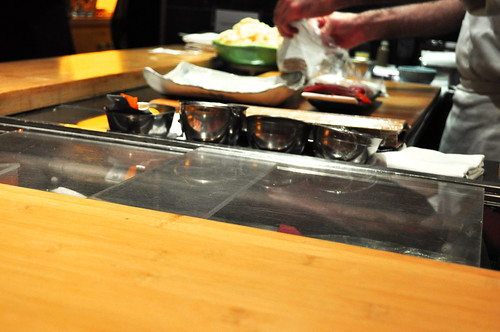

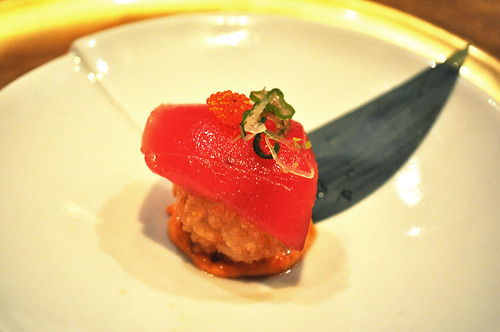



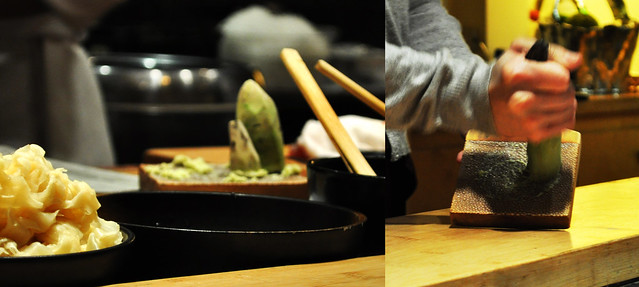
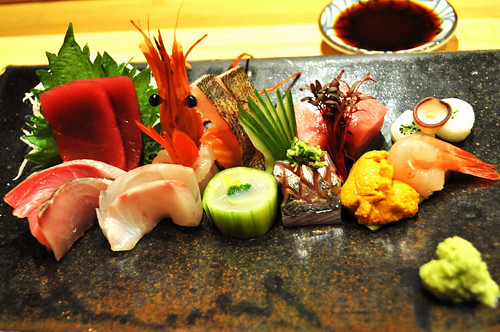
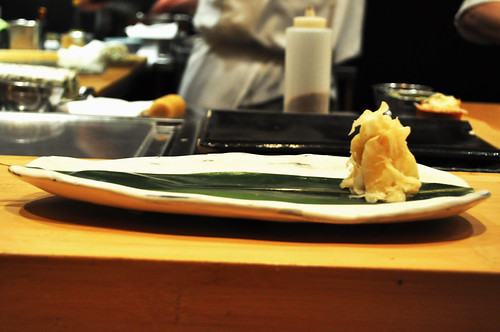
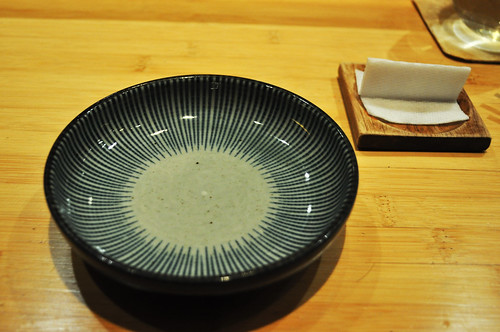

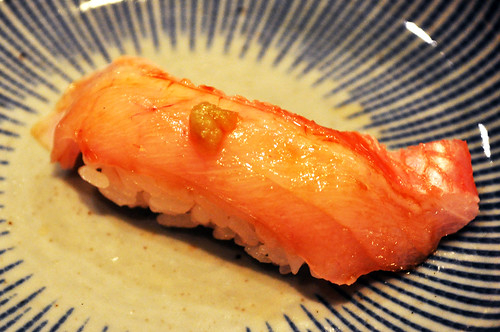
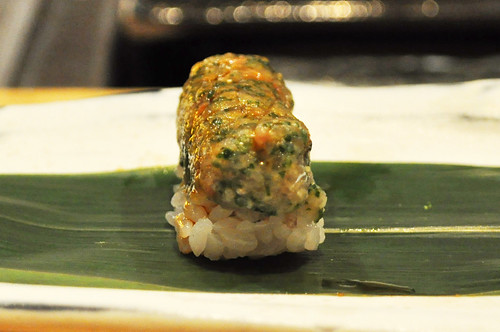
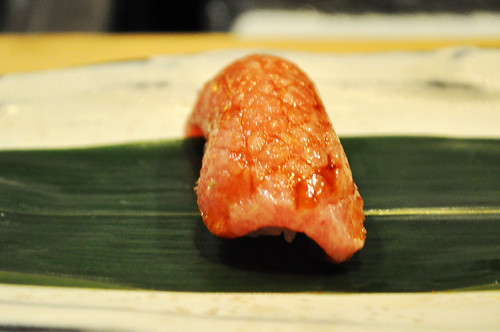

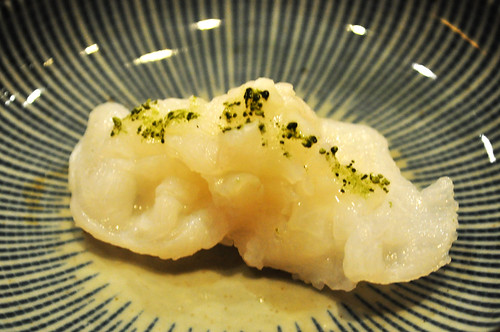


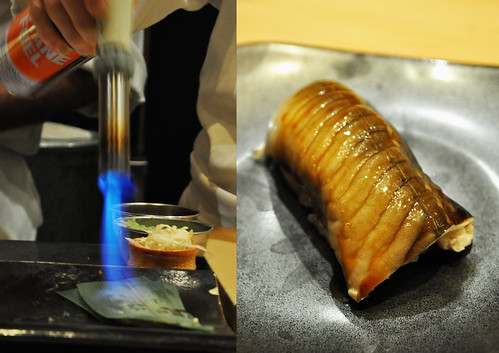

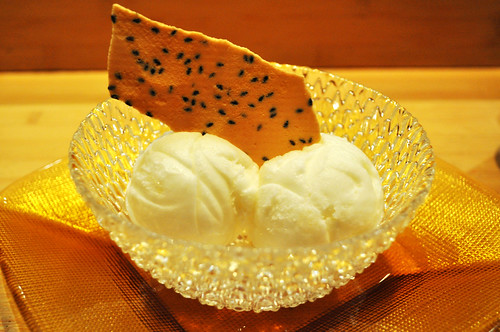
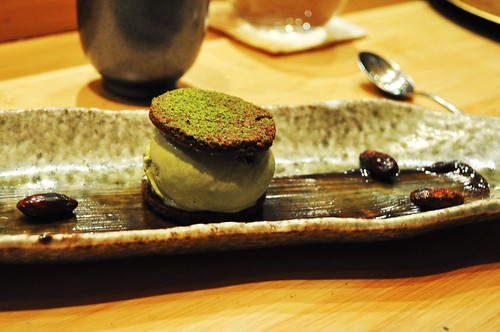

No comments:
Post a Comment